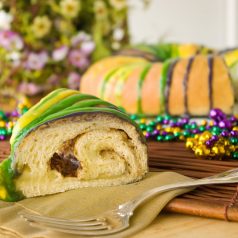
King Cake
Mardi Gras/Carnival season officially began on January 6th or the “Twelfth Night,” also known to Christians as the “Epiphany,” and culminates on Tuesday, February 21st – a day affectionately known as “Fat Tuesday”. While there are many traditional Mardi Gras dishes to enjoy during this time of feasting and revelry leading up to Lent, none is quite so ubiquitous as the king cake.
The rich history of the king cake dates all the way back to the Middle Ages with the first known king cakes baked in Europe in celebration of the Catholic Epiphany, also known as Three Kings Day on January 6th. The French brought the cake with them to the Gulf Coast region of the United States in the 1870s, and it has since become synonymous with American celebrations of Mardi Gras. The first Mardi Gras celebration in America took place in 1703 when a group of French soldiers held an impromptu celebration in the settlement of Mobile, Alabama.
While there are many regional variations, Mardi Gras king cakes found in most American bakeries are traditionally crown-shaped brioche-style confections decorated in royal colors of purple, green, and gold representing justice, faith, and power, respectively. They also typically contain a token of good fortune hidden within the cake, bestowing the recipient with luck and prosperity and the responsibility of providing the king cake for the next year’s festivities. This token is often represented as a bean, pea, or plastic baby.
You’ll find many of the ingredients needed to prepare your own Mardi Gras king cake in our weekly sale from February 16th – 22nd, so it’s a perfect time to give this traditional treat a try!
